Reservoir Quality Prediction of Gas-Bearing Carbonate Sediments in the Qadirpur Field: Insights from Advanced Machine Learning Approaches of SOM and Cluster Analysis
Abstract
1. Introduction
2. Geological Background of the Study Area
3. Data and Methods
3.1. Environmental Corrections
3.2. Petrophysical Parameters
3.2.1. Volume of Shale
3.2.2. Porosity Calculation
3.2.3. Permeability Calculation
3.2.4. Water Saturation
3.2.5. Hydrocarbon Saturation
3.3. Cut-off Estimation
3.4. Determination of Lithology Using Cross-Plots and the SOM
3.4.1. M–N Cross-Plot
3.4.2. PEF and RHOB Crossplot
3.4.3. Determination of Lithology Using SOM
3.5. Clusters Analysis
4. Results
4.1. Lithology
4.2. Water Saturation Assessment
4.3. Buckles Plot
4.4. Cut-off Determination
4.5. Spatial Variations
4.6. Cluster Analysis
5. Discussion
6. Conclusions
- In terms of lithology, the reservoir is mainly composed of Sui main limestone with little shale, while in terms of mineralogy, it is made up of calcite, as evidenced by the cross-plot results.
- The results of the cluster analysis show that the most intriguing parts of the Eocene reservoir for the Sui man limestone are in log facies 1 and 2.
- The effective thickness of a QGF rises within the northwest and southwest regions of the research area, whereas water saturation increases in the northeast and southwest parts, as a result of spatial variations throughout petrophysical features. Furthermore, the petrophysical information obtained from the QGF provides crucial data on regional geologic variations to facilitate future studies in the research area’s SW and NW onshore blocks.
Author Contributions
Funding
Data Availability Statement
Conflicts of Interest
References
- Ehsan, M.; Gu, H.; Ali, A.; Akhtar, M.M.; Abbasi, S.S.; Miraj, M.A.F.; Shah, M. An integrated approach to evaluate the unconventional hydrocarbon generation potential of the Lower Goru Formation (Cretaceous) in Southern Lower Indus basin, Pakistan. J. Earth Syst. Sci. 2021, 130, 90. [Google Scholar] [CrossRef]
- Hussain, M.; Liu, S.; Ashraf, U.; Ali, M.; Hussain, W.; Ali, N.; Anees, A. Application of machine learning for lithofacies prediction and cluster analysis approach to identify rock type. Energies 2022, 15, 4501. [Google Scholar] [CrossRef]
- Milad, M.; Junin, R.; Sidek, A.; Imqam, A.; Tarhuni, M. Huff-n-puff technology for enhanced oil recovery in shale/tight oil reservoirs: Progress, gaps, and perspectives. Energy Fuels 2021, 35, 17279–17333. [Google Scholar] [CrossRef]
- Alalimi, A.; AlRassas, A.M.; Vo Thanh, H.; Al-qaness, M.A.; Pan, L.; Ashraf, U.; AL-Alimi, D.; Moharam, S. Developing the efficiency-modeling framework to explore the potential of CO2 storage capacity of S3 reservoir, Tahe oilfield, China. Geomech. Geophys. Geo-Energy Geo-Resour. 2022, 8, 128. [Google Scholar] [CrossRef]
- Ashraf, U.; Zhang, H.; Anees, A.; Mangi, H.N.; Ali, M.; Zhang, X.; Imraz, M.; Abbasi, S.S.; Abbas, A.; Ullah, Z. A core logging, machine learning and geostatistical modeling interactive approach for subsurface imaging of lenticular geobodies in a clastic depositional system, SE Pakistan. Nat. Resour. Res. 2021, 30, 2807–2830. [Google Scholar] [CrossRef]
- Safaei-Farouji, M.; Thanh, H.V.; Dai, Z.; Mehbodniya, A.; Rahimi, M.; Ashraf, U.; Radwan, A.E. Exploring the power of machine learning to predict carbon dioxide trapping efficiency in saline aquifers for carbon geological storage project. J. Clean. Prod. 2022, 372, 133778. [Google Scholar] [CrossRef]
- Thanh, H.V.; Zamanyad, A.; Safaei-Farouji, M.; Ashraf, U.; Hemeng, Z. Application of hybrid artificial intelligent models to predict deliverability of underground natural gas storage sites. Renew. Energy 2022, 200, 169–184. [Google Scholar] [CrossRef]
- Graciolli, V.M. A Novel Classification Method Applied to Well Log Data Calibrated by Ontology Based Core Descriptions. Master’s Thesis, Universidade Federal do Rio Grande do Sul, Porto Alegre, Brazil, 2018. [Google Scholar]
- Ali, M.; Jiang, R.; Ma, H.; Pan, H.; Abbas, K.; Ashraf, U.; Ullah, J. Machine learning-A novel approach of well logs similarity based on synchronization measures to predict shear sonic logs. J. Pet. Sci. Eng. 2021, 203, 108602. [Google Scholar] [CrossRef]
- Jiang, R.; Ji, Z.; Mo, W.; Wang, S.; Zhang, M.; Yin, W.; Wang, Z.; Lin, Y.; Wang, X.; Ashraf, U. A Novel Method of Deep Learning for Shear Velocity Prediction in a Tight Sandstone Reservoir. Energies 2022, 15, 7016. [Google Scholar] [CrossRef]
- Shehata, A.A.; Osman, O.A.; Nabawy, B.S. Neural network application to petrophysical and lithofacies analysis based on multi-scale data: An integrated study using conventional well log, core and borehole image data. J. Nat. Gas Sci. Eng. 2021, 93, 104015. [Google Scholar] [CrossRef]
- Ali, N.; Chen, J.; Fu, X.; Hussain, W.; Ali, M.; Iqbal, S.M.; Anees, A.; Hussain, M.; Rashid, M.; Thanh, H.V. Classification of reservoir quality using unsupervised machine learning and cluster analysis: Example from Kadanwari gas field, SE Pakistan. Geosystems Geoenvironment 2023, 2, 100123. [Google Scholar] [CrossRef]
- Ikotun, A.M.; Ezugwu, A.E.; Abualigah, L.; Abuhaija, B.; Heming, J. K-means Clustering Algorithms: A Comprehensive Review, Variants Analysis, and Advances in the Era of Big Data. Inf. Sci. 2022, 622, 178–210. [Google Scholar] [CrossRef]
- Khan, M.; Arif, M.; Ali, N.; Yaseen, M.; Ahmed, A.; Siyar, S.M. Petrophysical parameters and modelling of the Eocene reservoirs in the Qadirpur area, Central Indus Basin, Pakistan: Implications from well log analysis. Arab. J. Geosci. 2016, 9, 425. [Google Scholar] [CrossRef]
- Ali, N.; Jamil, S.; Zaheer, M.; Hussain, W.; Hussain, H.; Muhammad Iqbal, S.; Ullah, H. Exploration and development of Shale gas in China: A review. Iran. J. Earth Sci. 2022, 14, 87–103. [Google Scholar]
- Muther, T.; Qureshi, H.A.; Syed, F.I.; Aziz, H.; Siyal, A.; Dahaghi, A.K.; Negahban, S. Unconventional hydrocarbon resources: Geological statistics, petrophysical characterization, and field development strategies. J. Pet. Explor. Prod. Technol. 2021, 12, 1463–1488. [Google Scholar] [CrossRef]
- Shar, A.M.; Mahesar, A.A.; Abbasi, G.R.; Narejo, A.A.; Hakro, A.A.A.D. Influence of diagenetic features on petrophysical properties of fine-grained rocks of Oligocene strata in the Lower Indus Basin, Pakistan. Open Geosci. 2021, 13, 517–531. [Google Scholar] [CrossRef]
- Ali, N.; Fu, X.; Ashraf, U.; Chen, J.; Thanh, H.V.; Anees, A.; Riaz, M.S.; Fida, M.; Hussain, M.A.; Hussain, S. Remote Sensing for Surface Coal Mining and Reclamation Monitoring in the Central Salt Range, Punjab, Pakistan. Sustainability 2022, 14, 9835. [Google Scholar] [CrossRef]
- Mahmoud, A.A.; Elkatatny, S.; Abdulraheem, A. Machine Learning Applications in the Petroleum Industry. In Handbook of Energy Transitions; CRC Press: Boca Raton, FL, USA, 2022; pp. 287–304. [Google Scholar]
- Ashraf, U.; Zhang, H.; Anees, A.; Ali, M.; Zhang, X.; Shakeel Abbasi, S.; Nasir Mangi, H. Controls on reservoir heterogeneity of a shallow-marine reservoir in Sawan Gas Field, SE Pakistan: Implications for reservoir quality prediction using acoustic impedance inversion. Water 2020, 12, 2972. [Google Scholar] [CrossRef]
- Bashir, Y.; Faisal, M.A.; Biswas, A.; Ali, S.H.; Imran, Q.S.; Siddiqui, N.A.; Ehsan, M. Seismic expression of miocene carbonate platform and reservoir characterization through geophysical approach: Application in central Luconia, offshore Malaysia. J. Pet. Explor. Prod. 2021, 11, 1533–1544. [Google Scholar] [CrossRef]
- Khalil Khan, H.; Ehsan, M.; Ali, A.; Amer, M.A.; Aziz, H.; Khan, A.; Bashir, Y.; Abu-Alam, T.; Abioui, M. Source rock geochemical assessment and estimation of TOC using well logs and geochemical data of Talhar Shale, Southern Indus Basin, Pakistan. Front. Earth Sci. 2022, 10, 1593. [Google Scholar] [CrossRef]
- Gozel, M.E.; Uysal, S.; Ayan, C.; Yuce, U.; Ozturk, E.; Gune, H.K.; Yilmaz, I.S.; Oymael, M.; Eswein, E. Acid Fracturing Experience In Naturally Fractured–Heavy Oil Reservoir, Bati Raman Field. In Proceedings of the SPE Annual Technical Conference and Exhibition, Dubai, United Arab Emirates, 21–23 September 2021. [Google Scholar]
- Yao, Y.; Sun, X.; Zheng, S.; Wu, H.; Zhang, C.; Liu, Y.; Chang, Y. Methods for petrological and petrophysical characterization of gas shales. Energy Fuels 2021, 35, 11061–11088. [Google Scholar] [CrossRef]
- Tamaki, M.; Fujimoto, A.; Boswell, R.; Collett, T.S. Geological reservoir characterization of a gas hydrate prospect associated with the Hydrate-01 stratigraphic test well, Alaska North Slope. Energy Fuels 2022, 36, 8128–8149. [Google Scholar] [CrossRef]
- Ullah, S.; Jan, I.U.; Hanif, M.; Latif, K.; Mohibullah, M.; Sabba, M.; Anees, A.; Ashraf, U.; Vo Thanh, H. Paleoenvironmental and bio-sequence stratigraphic analysis of the cretaceous pelagic carbonates of eastern tethys, sulaiman range, Pakistan. Minerals 2022, 12, 946. [Google Scholar] [CrossRef]
- Ali, N.; Chen, J.; Fu, X.; Hussain, W.; Ali, M.; Hussain, M.; Anees, A.; Rashid, M.; Thanh, H.V. Prediction of Cretaceous reservoir zone through petrophysical modeling: Insights from Kadanwari gas field, Middle Indus Basin. Geosystems Geoenvironment 2022, 1, 100058. [Google Scholar] [CrossRef]
- Wang, E.; Feng, Y.; Guo, T.; Li, M. Oil content and resource quality evaluation methods for lacustrine shale: A review and a novel three-dimensional quality evaluation model. Earth-Sci. Rev. 2022, 232, 104134. [Google Scholar] [CrossRef]
- Ali, J.; Ashraf, U.; Anees, A.; Peng, S.; Umar, M.U.; Vo Thanh, H.; Khan, U.; Abioui, M.; Mangi, H.N.; Ali, M. Hydrocarbon potential assessment of carbonate-bearing sediments in a meyal oil field, Pakistan: Insights from logging data using machine learning and quanti elan modeling. ACS Omega 2022, 7, 39375–39395. [Google Scholar] [CrossRef]
- Talib, M.; Durrani, M.Z.A.; Palekar, A.H.; Sarosh, B.; Rahman, S.A. Quantitative characterization of unconventional (tight) hydrocarbon reservoir by integrating rock physics analysis and seismic inversion: A case study from the Lower Indus Basin of Pakistan. Acta Geophys. 2022, 70, 2715–2731. [Google Scholar] [CrossRef]
- Durrani, M.Z.A.; Talib, M.; Ali, A.; Sarosh, B.; Naseem, N. Characterization and probabilistic estimation of tight carbonate reservoir properties using quantitative geophysical approach: A case study from a mature gas field in the Middle Indus Basin of Pakistan. J. Pet. Explor. Prod. Technol. 2020, 10, 2785–2804. [Google Scholar] [CrossRef]
- Malkani, M.S.; Mahmood, Z. Revised stratigraphy of Pakistan. Geol. Surv. Pak. Rec. 2016, 127, 1–87. [Google Scholar]
- Tainsh, H.; Stringer, K.; Azad, J. Major gas fields of West Pakistan. AAPG Bull. 1959, 43, 2675–2700. [Google Scholar]
- Dar, Q.U.; Pu, R.; Baiyegunhi, C.; Shabeer, G.; Ali, R.I.; Ashraf, U.; Sajid, Z.; Mehmood, M. The impact of diagenesis on the reservoir quality of the early Cretaceous Lower Goru sandstones in the Lower Indus Basin, Pakistan. J. Pet. Explor. Prod. Technol. 2022, 12, 1437–1452. [Google Scholar] [CrossRef]
- Jadoon, S.-U.-R.K.; Lin, D.; Ehsan, S.A.; Jadoon, I.A.; Idrees, M. Structural styles, hydrocarbon prospects, and potential of Miano and Kadanwari fields, Central Indus Basin, Pakistan. Arab. J. Geosci. 2020, 13, 97. [Google Scholar] [CrossRef]
- Khan, M.; Abdelmaksoud, A. Unfolding impacts of freaky tectonics on sedimentary sequences along passive margins: Pioneer findings from western Indian continental margin (Offshore Indus Basin). Mar. Pet. Geol. 2020, 119, 104499. [Google Scholar] [CrossRef]
- Naseer, M.T.; Radwan, A.E.; Naseem, S. Seismic attributes and static reservoir simulation applications for imaging the thin-bedded stratigraphic systems: A case study of the Lower-Cretaceous Lower Goru fluvial resources, Pakistan. J. Asian Earth Sci. 2022, 240, 105409. [Google Scholar] [CrossRef]
- Qureshi, M.A.; Ghazi, S.; Riaz, M.; Ahmad, S. Geo-seismic model for petroleum plays an assessment of the Zamzama area, Southern Indus Basin, Pakistan. J. Pet. Explor. Prod. 2021, 11, 33–44. [Google Scholar] [CrossRef]
- Maqsood, T.; Kelly, J.; Ahmad, S.; Ahsan, N.; Tahir, R. Speculative Tectonic Model and Hydrocarbon Play System in Outer Himalyian Foldbelt of Kashmir. In Proceedings of the SPE Annual Technical Conference, Islamabad, Pakistan, 25–26 November 2014. [Google Scholar]
- GHAZI, J.M.; Moazzen, M. Geodynamic evolution of the Sanandaj-Sirjan zone, Zagros orogen, Iran. Turk. J. Earth Sci. 2015, 24, 513–528. [Google Scholar] [CrossRef]
- Shahzad, K.; Betzler, C.; Ahmed, N.; Qayyum, F.; Spezzaferri, S.; Qadir, A. Growth and demise of a Paleogene isolated carbonate platform of the Offshore Indus Basin, Pakistan: Effects of regional and local controlling factors. Int. J. Earth Sci. 2018, 107, 481–504. [Google Scholar] [CrossRef]
- Kassi, A.M.; Kelling, G.; Kasi, A.K.; Umar, M.; Khan, A.S. Contrasting Late Cretaceous–Palaeocene lithostratigraphic successions across the Bibai Thrust, western Sulaiman Fold–Thrust Belt, Pakistan: Their significance in deciphering the early-collisional history of the NW Indian Plate margin. J. Asian Earth Sci. 2009, 35, 435–444. [Google Scholar] [CrossRef]
- Iqbal, M.; Khan, M.R. Impact of Indo-Pakistan and Eurasian Plates Collision in the Sulaiman Fold Belt, Pakistan. Search Discov. Artic. 2012, 2012, 50575. [Google Scholar]
- Aziz, E.A.; Gomaa, M.M. Petrophysical analysis of well logs and core samples for reservoir evaluation: A case study of southern Issaran Field, Gulf of Suez province, Egypt. Environ. Earth Sci. 2022, 81, 341. [Google Scholar] [CrossRef]
- Abdolahi, A.; Chehrazi, A.; Kadkhodaie, A.; Seyedali, S. Identification and modeling of the hydrocarbon-bearing Ghar sand using seismic attributes, wireline logs and core information, a case study on Asmari Formation in Hendijan Field, southwest part of Iran. Model. Earth Syst. Environ. 2022, 1–18. [Google Scholar] [CrossRef]
- Ong, D.E.L.; Barla, M.; Cheng, J.W.-C.; Choo, C.S.; Sun, M.; Peerun, M.I. Investigation Techniques: Pipe Jacking in Complex Geology. In Sustainable Pipe Jacking Technology in the Urban Environment; Springer: Berlin/Heidelberg, Germany, 2022; pp. 7–41. [Google Scholar]
- Hussain, W.; Ali, N.; Sadaf, R.; Hu, C.; Nykilla, E.E.; Ullah, A.; Iqbal, S.M.; Hussain, A.; Hussain, S. Petrophysical analysis and hydrocarbon potential of the lower Cretaceous Yageliemu Formation in Yakela gas condensate field, Kuqa Depression of Tarim Basin, China. Geosystems Geoenvironment 2022, 1, 100106. [Google Scholar] [CrossRef]
- Wang, S.; Wang, G.; Huang, L.; Song, L.; Zhang, Y.; Li, D.; Huang, Y. Logging evaluation of lamina structure and reservoir quality in shale oil reservoir of Fengcheng Formation in Mahu Sag, China. Mar. Pet. Geol. 2021, 133, 105299. [Google Scholar] [CrossRef]
- Zhu, L.-Q.; Sun, J.; Zhou, X.-Q.; Li, Q.-P.; Fan, Q.; Wu, S.-L.; Wu, S.-G. Well logging evaluation of fine-grained hydrate-bearing sediment reservoirs: Considering the effect of clay content. Pet. Sci. 2022. [Google Scholar] [CrossRef]
- Pan, B.; Wang, X.; Guo, Y.; Zhang, L.; Ruhan, A.; Zhang, N.; Zhang, P.; Li, Y. Study on reservoir characteristics and evaluation methods of altered igneous reservoirs in Songliao Basin, China. J. Pet. Sci. Eng. 2022, 212, 110266. [Google Scholar] [CrossRef]
- Hossain, S.; Junayed, T.R.; Haque, A. Rock physics diagnostics and modelling of the Mangahewa Formation of the Maui B gas field, Taranaki Basin, offshore New Zealand. Arab. J. Geosci. 2022, 15, 1177. [Google Scholar] [CrossRef]
- Shahrina, R.J.R.K.; Sideka, A.; Agia, A.; Junina, R.; Jaafara, M.Z.; Ariffinc, H. Comparison of Water Saturation Models Based on Well Logging Data: A Case Study of MX Field in Malay Basin. J. Kejuruter. 2022, 34, 101–108. [Google Scholar] [CrossRef]
- Daniel, D. Machine Learning for Pay Zone Identification in the Smørbukk Field Using Well Logs and XRF Data. Master’s Thesis, University of Stavanger, Stavanger, Norway, 2022. [Google Scholar]
- Ding, W.; Ming, Y.; Wang, Y.-K.; Lin, C.-T. Memory augmented convolutional neural network and its application in bioimages. Neurocomputing 2021, 466, 128–138. [Google Scholar] [CrossRef]
- Ezugwu, A.E.; Ikotun, A.M.; Oyelade, O.O.; Abualigah, L.; Agushaka, J.O.; Eke, C.I.; Akinyelu, A.A. A comprehensive survey of clustering algorithms: State-of-the-art machine learning applications, taxonomy, challenges, and future research prospects. Eng. Appl. Artif. Intell. 2022, 110, 104743. [Google Scholar] [CrossRef]
- Bakke, D. Different Strokes for Different Folks: Patient-Specific Gait Modelling and Post-Stroke Rehabilitation; ResearchSpace: Auckland, New Zealand, 2022. [Google Scholar]
- Sarker, I.H. Deep learning: A comprehensive overview on techniques, taxonomy, applications and research directions. SN Comput. Sci. 2021, 2, 420. [Google Scholar] [CrossRef]
- Zi, K.; Wang, S.; Liu, Y.; Li, J.; Cao, Y.; Cao, C. SOM-NCSCM: An Efficient Neural Chinese Sentence Compression Model Enhanced with Self-Organizing Map. In Proceedings of the 2021 Conference on Empirical Methods in Natural Language Processing, Punta Cana, Dominican Republic, 7–11 November 2021; pp. 403–415. [Google Scholar]
- Aliashrafi, A.; Zhang, Y.; Groenewegen, H.; Peleato, N.M. A review of data-driven modelling in drinking water treatment. Rev. Environ. Sci. Bio/Technol. 2021, 20, 985–1009. [Google Scholar] [CrossRef]
- Sarkar, S.; Ejaz, N.; Maiti, J.; Pramanik, A. An integrated approach using growing self-organizing map-based genetic K-means clustering and tolerance rough set in occupational risk analysis. Neural Comput. Appl. 2022, 34, 9661–9687. [Google Scholar] [CrossRef]
- Gawehn, E. Leveraging Self-Organizing Maps with Convolutional Neural Networks for Virtual Chemical Library Screening; ETH: Zurich, Switzerland, 2022. [Google Scholar]
- Kohonen, T. Self-organizing maps: Ophmization approaches. In Artificial Neural Networks; Elsevier: Amsterdam, The Netherlands, 1991; pp. 981–990. [Google Scholar]
- You, L.; Jiang, H.; Hu, J.; Chang, C.H.; Chen, L.; Cui, X.; Zhao, M. GPU-accelerated Faster Mean Shift with euclidean distance metrics. In Proceedings of the 2022 IEEE 46th Annual Computers, Software, and Applications Conference (COMPSAC), Los Alamitos, CA, USA, 27 June–1 July 2022; pp. 211–216. [Google Scholar]
- Saha, S.; Vishal, V. Rock strength estimation from petrophysical logs through core data calibration in low porosity and low permeability carbonate rocks. In Handbook of Petroleum Geoscience: Exploration, Characterization, and Exploitation of Hydrocarbon Reservoirs; John Wiley & Sons: Hoboken, NJ, USA, 2022; p. 137. [Google Scholar]
- Ashraf, U.; Zhang, H.; Anees, A.; Nasir Mangi, H.; Ali, M.; Ullah, Z.; Zhang, X. Application of unconventional seismic attributes and unsupervised machine learning for the identification of fault and fracture network. Appl. Sci. 2020, 10, 3864. [Google Scholar] [CrossRef]
- Fea, I.; Abioui, M.; Nabawy, B.S.; Jain, S.; Bruno, D.Z.; Kassem, A.A.; Benssaou, M. Reservoir quality discrimination of the Albian-Cenomanian reservoir sequences in the Ivorian basin: A lithological and petrophysical study. Geomech. Geophys. Geo-Energy Geo-Resour. 2022, 8, 1. [Google Scholar] [CrossRef]
- Freund, Y. Boosting a weak learning algorithm by majority. Inf. Comput. 1995, 121, 256–285. [Google Scholar] [CrossRef]
- Ali, M.; Ma, H.; Pan, H.; Ashraf, U.; Jiang, R. Building a rock physics model for the formation evaluation of the Lower Goru sand reservoir of the Southern Indus Basin in Pakistan. J. Pet. Sci. Eng. 2020, 194, 107461. [Google Scholar] [CrossRef]
- Al-Jawad, S.N.; Saleh, A.H. Flow units and rock type for reservoir characterization in carbonate reservoir: Case study, south of Iraq. J. Pet. Explor. Prod. Technol. 2020, 10, 1–20. [Google Scholar] [CrossRef]
- Looker, A.C.; Dallman, P.R.; Carroll, M.D.; Gunter, E.W.; Johnson, C.L. Prevalence of iron deficiency in the United States. JAMA 1997, 277, 973–976. [Google Scholar] [CrossRef]
- Ahr, W.M.; Allen, D.; Boyd, A.; Bachman, H.N.; Smithson, T.; Clerke, E.; Gzara, K.; Hassall, J.; Murty, C.; Zubari, H. Confronting the carbonate conundrum. Oilfield Rev. 2005, 17, 18–29. [Google Scholar]
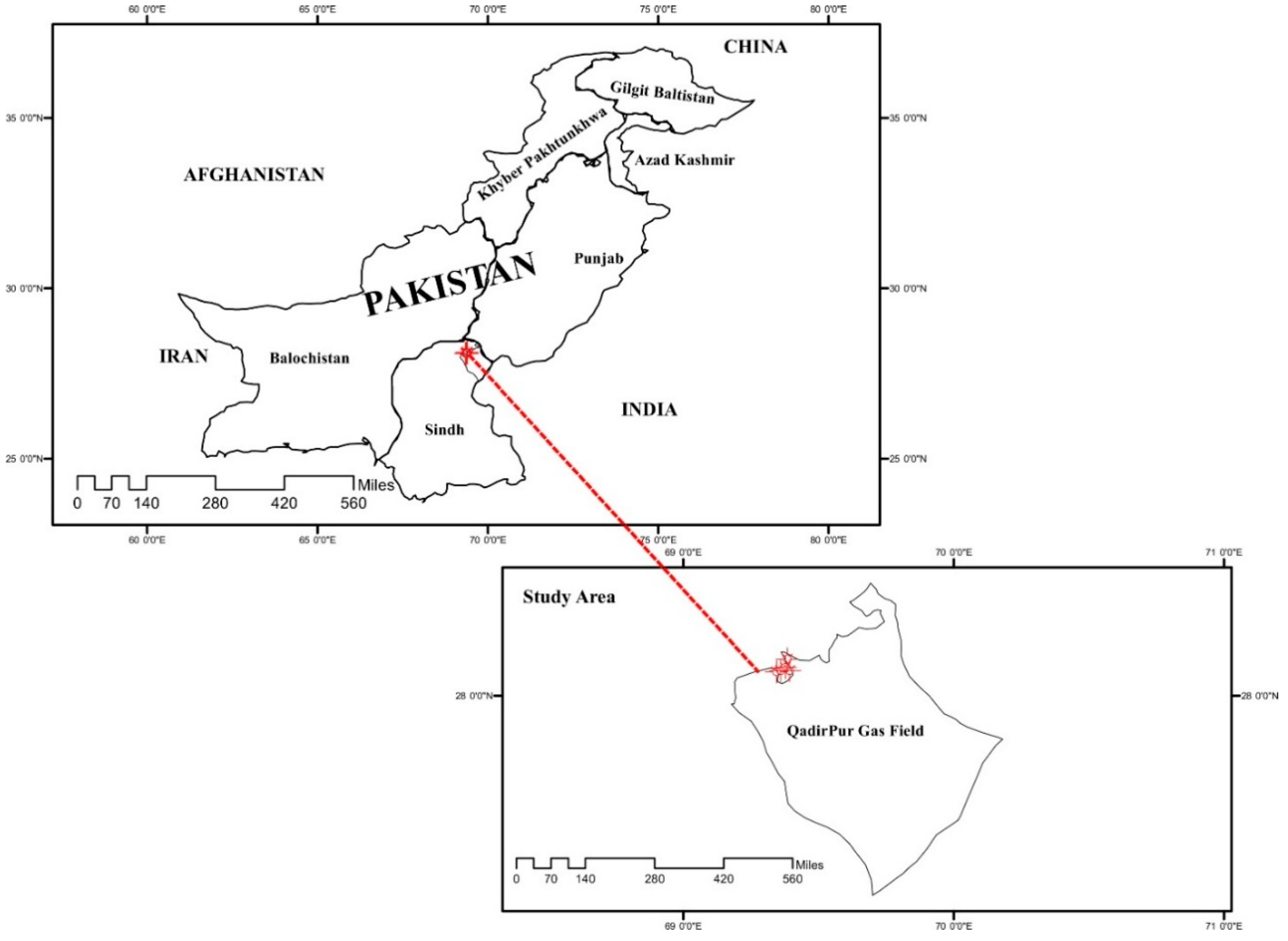


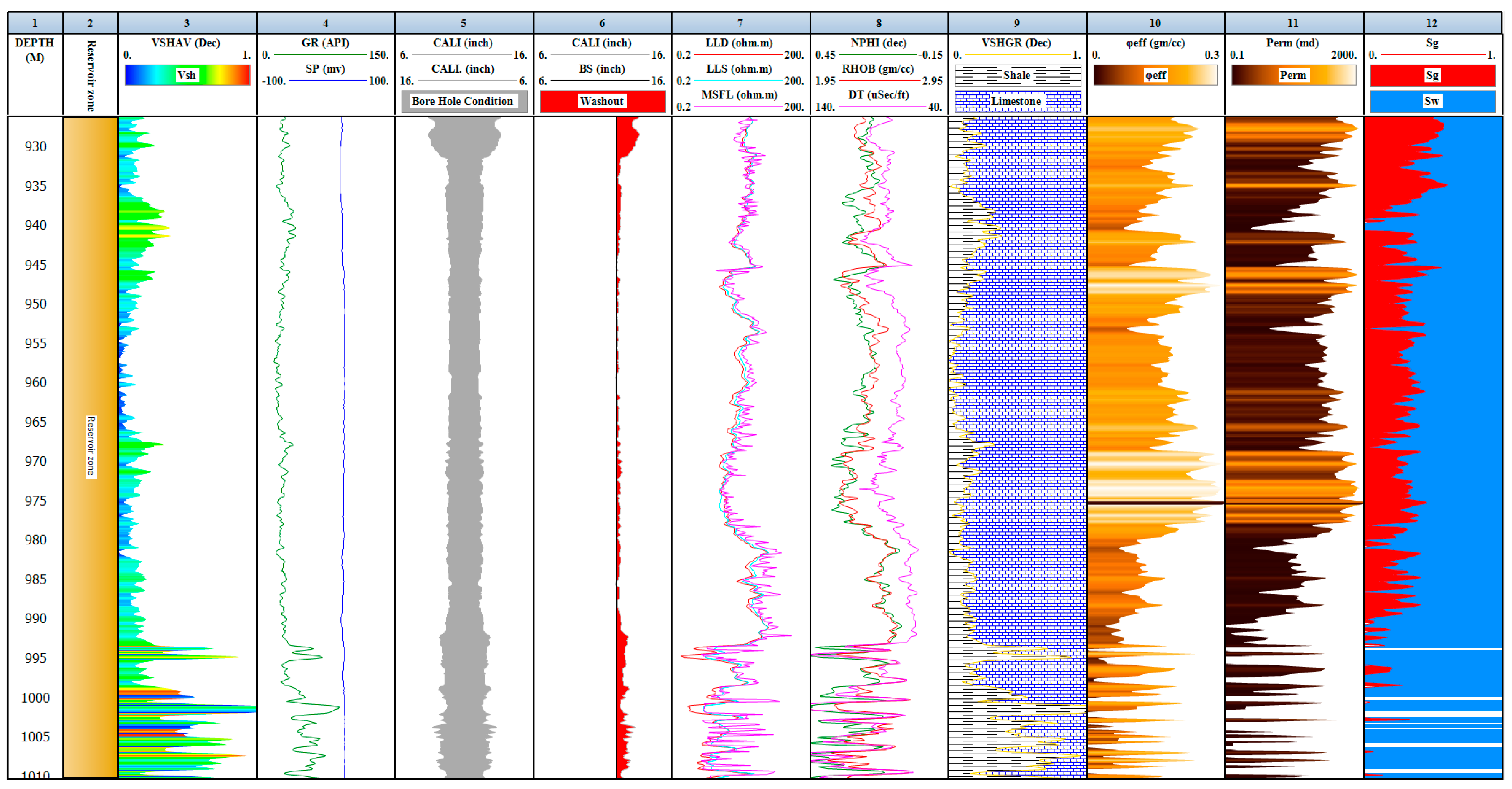
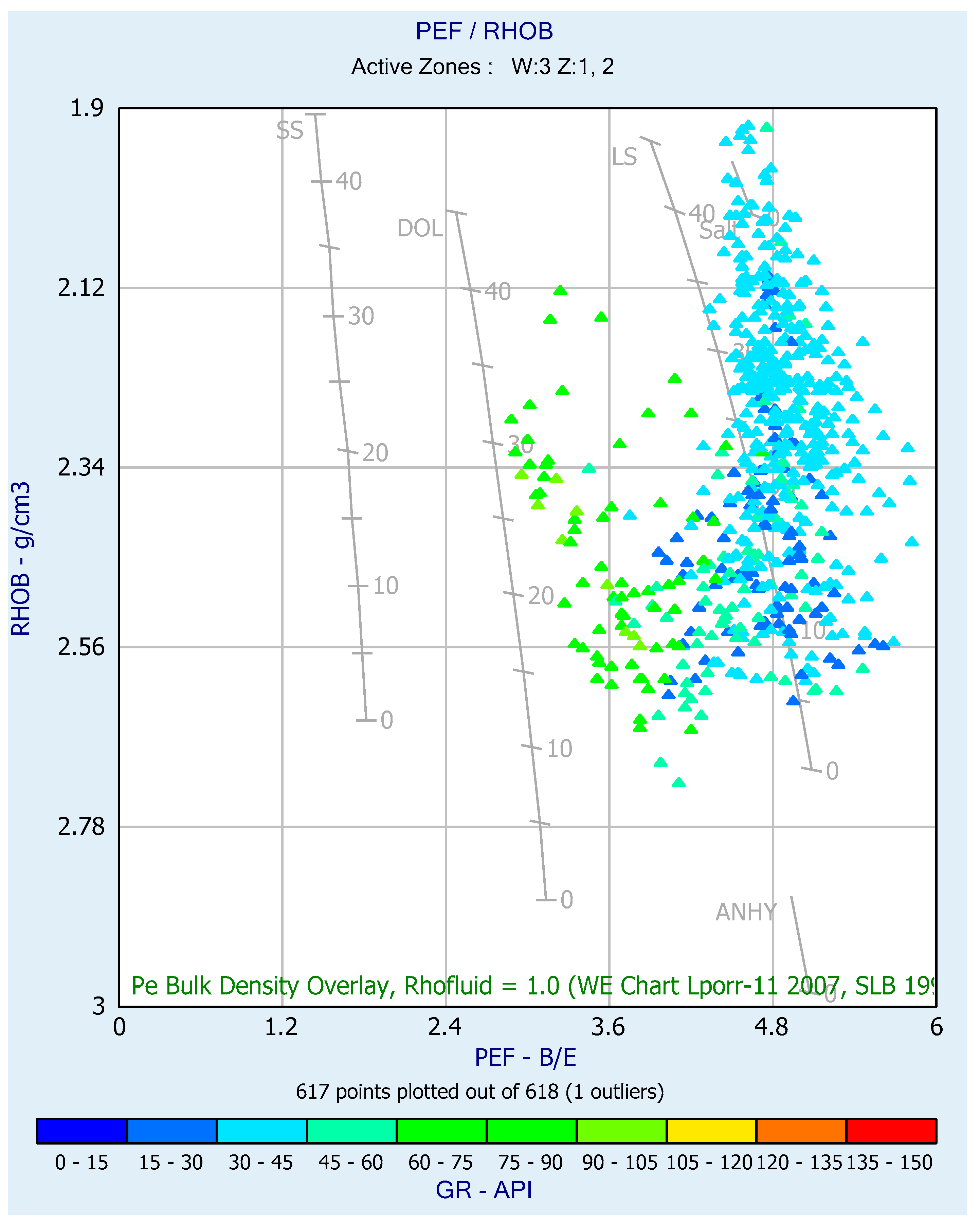

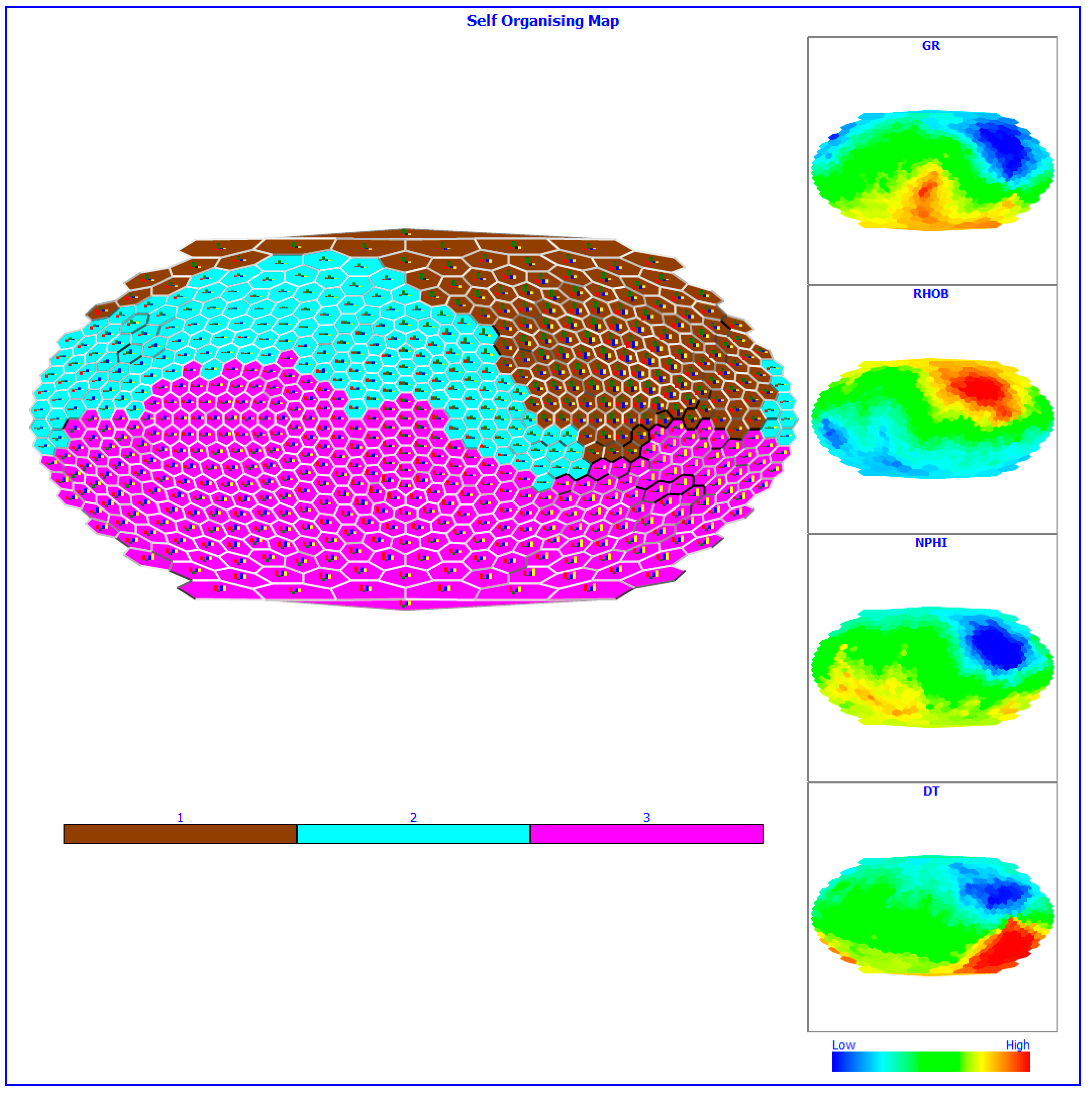




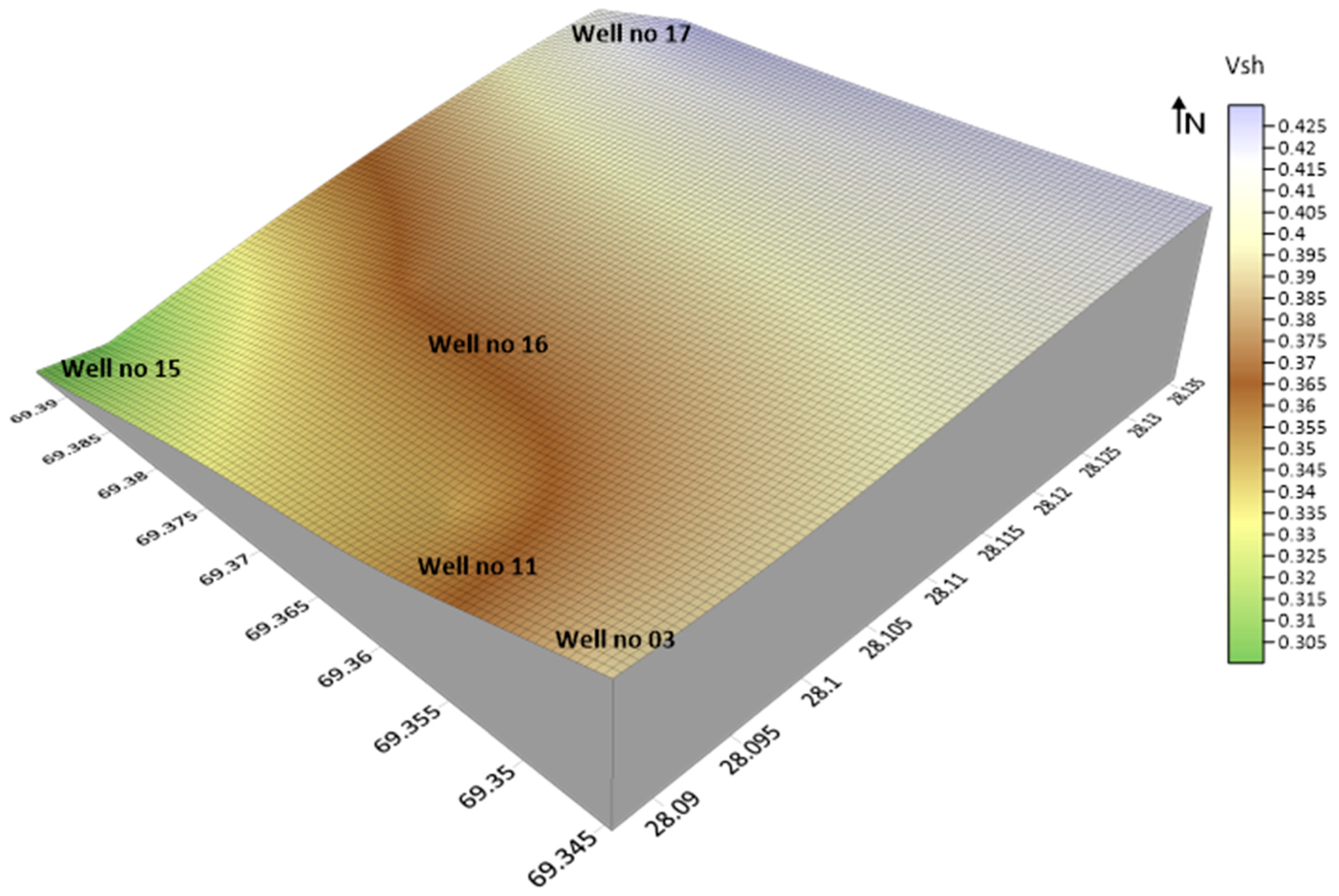



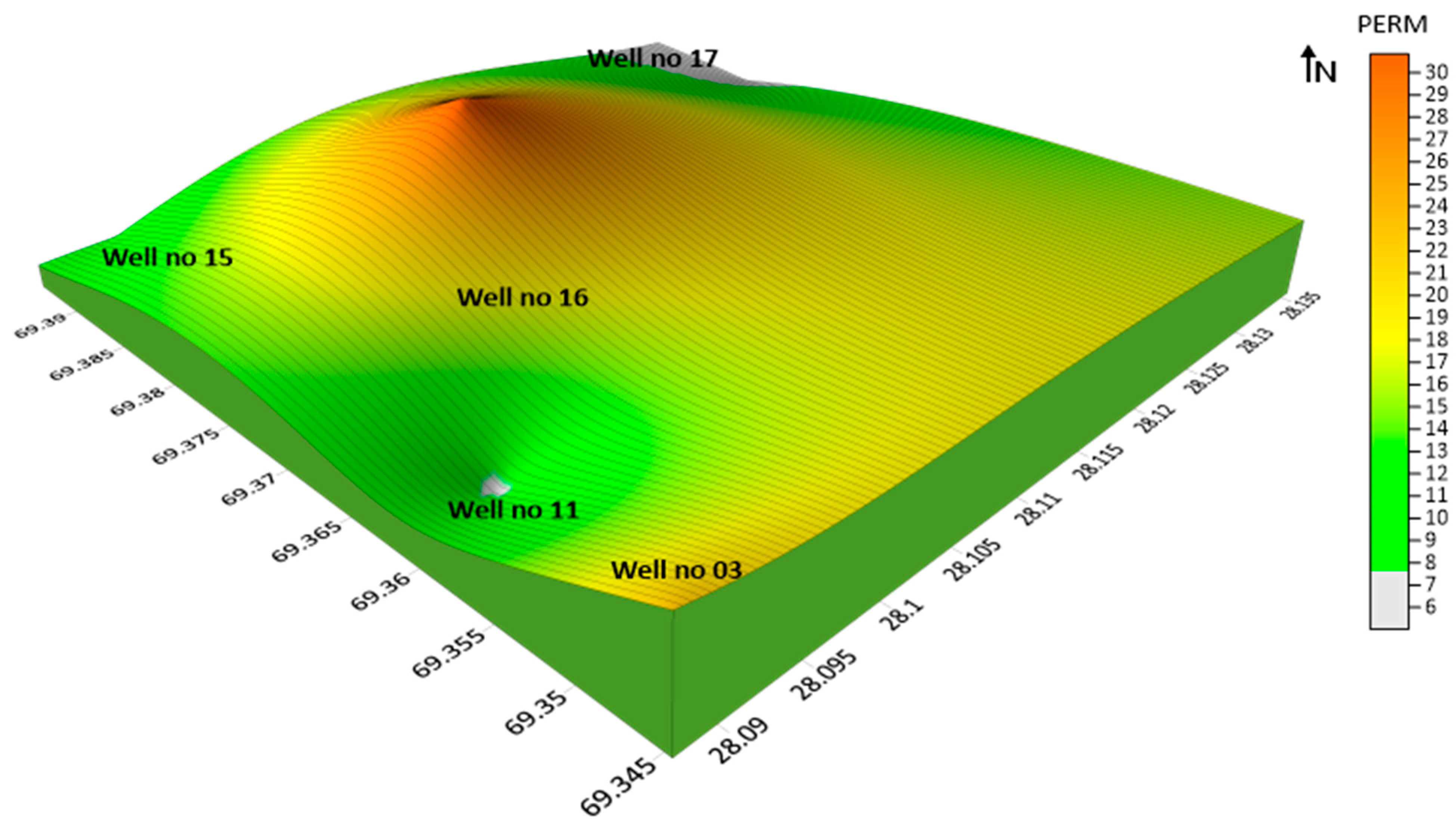


| Well Logs | Signs | Physical Features | QGF-03 (Depth, m) | QGF-11 (Depth, m) | QGF-15 (Depth, m) | QGF-16 (Depth, m) | QGF-17 (Depth, m) |
|---|---|---|---|---|---|---|---|
| Bulk density | RHOB | Density | 836–1342 | 860–1408 | 1653–1786 | 837–1382 | 693–1401 |
| Deep resistivity | LLD | Uninvaded zone resistivity | 831–1342 | 393–1403 | 1653–1783 | 387–1377 | 357–1396 |
| Photoelectric | PEF | Photoelectric effect | 688–1399 | 860–1408 | 1537–1791 | 837–1382 | 693–1402 |
| Sonic | DT | Compressional slowness | 394–1342 | 390–1407 | 1630–1790 | 380–1380 | 372–1405 |
| Shallow resistivity | LLS | Invaded zone resistivity | 830–1344 | 389–1402 | 1653–1786 | 386–1377 | 357–1390 |
| Self-potential | SP | Natural log | 831–1322 | 389–1403 | 1660–1790 | 386–1377 | 357–1400 |
| Gamma ray | GR | Radioactivity | 381–1346 | 388–1403 | 1537–1791 | 380–1390 | 357–1400 |
| Neutron porosity | NPHI | Porosity | 836–1340 | 860–1408 | 1537–1791 | 837–1382 | 693–1378 |
| Well ID | a | m | n | Rw |
|---|---|---|---|---|
| Qadirpur-03 | 1 | 1.9 | 2 | 0.007 |
| Qadirpur-11 | 1 | 1.9 | 2 | 0.007 |
| Qadirpur-15 | 1 | 1.9 | 2 | 0.007 |
| Qadirpur-16 | 1 | 1.9 | 2 | 0.007 |
| Qadirpur-17 | 1 | 1.9 | 2 | 0.007 |
| S. No.Well | Proposed Zone Top Bottom | Thickness (m) | Φeff % | K mD | Vsh % | Sw % | Sg % |
|---|---|---|---|---|---|---|---|
| Qadirpur-3 | 1010 1220 | 210 | 12 | 22 | 39 | 51 | 49 |
| Qadirpur-11 | 927 1145 | 218 | 8 | 7 | 35 | 42 | 58 |
| Qadirpur-15 | 1734 1784 | 50 | 9 | 8 | 30 | 38 | 62 |
| Qadirpur-16 | 900 940 | 40 | 10 | 11 | 37 | 55 | 45 |
| Qadirpur-17 | 925 1010 | 85 | 14 | 5 | 43 | 46 | 54 |
| K-Mean Clustering Results | ||||||
|---|---|---|---|---|---|---|
| Facies | Points | Rock Typing | GR Mean | Φeff Mean | Perm Mean | Sw Mean |
| 1 | 137 | Excellent-quality rock type | 58.873 | 0.05641 | 38.474 | 0.52641 |
| 2 | 16 | Good-quality rock type | 86.53 | 0.00833 | 0.37459 | 0.3541 |
| 3 | 41 | Moderate-quality rock type | 90.967 | 0.14072 | 637.82 | 0.30895 |
| 4 | 109 | Poor-quality rock type | 92.27 | 0.08073 | 134.89 | 0.53928 |
| S. No | Rock Typing | GR | Φeff | Perm | Sw |
|---|---|---|---|---|---|
| Facies-01 | Excellent-quality rock type | Very low | Good to excellent | Good to excellent | Very low |
| Facies-02 | Good-quality rock type | Low | Good | good | low |
| Facies-03 | Moderate-quality rock type | Medium | Fair to good | Fair to good | Medium |
| Facies-04 | Poor-quality rock type | High | Low | Low | Very high |
Disclaimer/Publisher’s Note: The statements, opinions and data contained in all publications are solely those of the individual author(s) and contributor(s) and not of MDPI and/or the editor(s). MDPI and/or the editor(s) disclaim responsibility for any injury to people or property resulting from any ideas, methods, instructions or products referred to in the content. |
© 2022 by the authors. Licensee MDPI, Basel, Switzerland. This article is an open access article distributed under the terms and conditions of the Creative Commons Attribution (CC BY) license (https://creativecommons.org/licenses/by/4.0/).
Share and Cite
Rashid, M.; Luo, M.; Ashraf, U.; Hussain, W.; Ali, N.; Rahman, N.; Hussain, S.; Aleksandrovich Martyushev, D.; Vo Thanh, H.; Anees, A. Reservoir Quality Prediction of Gas-Bearing Carbonate Sediments in the Qadirpur Field: Insights from Advanced Machine Learning Approaches of SOM and Cluster Analysis. Minerals 2023, 13, 29. https://doi.org/10.3390/min13010029
Rashid M, Luo M, Ashraf U, Hussain W, Ali N, Rahman N, Hussain S, Aleksandrovich Martyushev D, Vo Thanh H, Anees A. Reservoir Quality Prediction of Gas-Bearing Carbonate Sediments in the Qadirpur Field: Insights from Advanced Machine Learning Approaches of SOM and Cluster Analysis. Minerals. 2023; 13(1):29. https://doi.org/10.3390/min13010029
Chicago/Turabian StyleRashid, Muhammad, Miao Luo, Umar Ashraf, Wakeel Hussain, Nafees Ali, Nosheen Rahman, Sartaj Hussain, Dmitriy Aleksandrovich Martyushev, Hung Vo Thanh, and Aqsa Anees. 2023. "Reservoir Quality Prediction of Gas-Bearing Carbonate Sediments in the Qadirpur Field: Insights from Advanced Machine Learning Approaches of SOM and Cluster Analysis" Minerals 13, no. 1: 29. https://doi.org/10.3390/min13010029
APA StyleRashid, M., Luo, M., Ashraf, U., Hussain, W., Ali, N., Rahman, N., Hussain, S., Aleksandrovich Martyushev, D., Vo Thanh, H., & Anees, A. (2023). Reservoir Quality Prediction of Gas-Bearing Carbonate Sediments in the Qadirpur Field: Insights from Advanced Machine Learning Approaches of SOM and Cluster Analysis. Minerals, 13(1), 29. https://doi.org/10.3390/min13010029












